|
TRANSLATE THIS ARTICLE
Integral World: Exploring Theories of Everything
An independent forum for a critical discussion of the integral philosophy of Ken Wilber
 Martin Erdmann is a German writer, poet, retired lecturer of Heidelberg University. He completed studies of English, French, and of legal science, both at the University of Heidelberg. He wrote several books in German focusing on the illusion of the I or Ego. As a cofounder of the German Spiritual Emergence Network (S. E. N) he provided counseling to people undergoing spiritual crises. For several years now he has conducted seminars on Advaita-Vedanta. (email: [email protected] Homepage: www.satsa.de) Martin Erdmann is a German writer, poet, retired lecturer of Heidelberg University. He completed studies of English, French, and of legal science, both at the University of Heidelberg. He wrote several books in German focusing on the illusion of the I or Ego. As a cofounder of the German Spiritual Emergence Network (S. E. N) he provided counseling to people undergoing spiritual crises. For several years now he has conducted seminars on Advaita-Vedanta. (email: [email protected] Homepage: www.satsa.de)EmptinessPart II: The World seen as EmptinessMartin ErdmannAbstractBuddha with the eye of contemplation saw consciousness as emptiness, as blissful nirvana, as the great void. This was an emptiness, an absolute seen as separate from the world of relativity, of samsara. Then came Nagarjuna, who in a supreme vision saw the whole world of samsara, of relativity, as blissful emptiness. Not content to keep the revelation to himself, he sat down to logically unveil the pure emptiness of samsara. The eye of mind, which always sees some-thing, cannot see the world as no-thing. By making a correct use of the discerning mind, one can, however, demonstrate that the whole world of relativity is emptiness, is the absolute. This is what the present article wants to accomplish. It will only partly rely on Nagarjuna's deliberations on the subject. To point out the emptiness of the world I will mainly draw on my own line of argument. It should be understood that this is not meant as a metaphysical project to be conveyed in a postmetaphysical age. To employ an old Zen adage: The finger pointing to the moon is not the moon. The message here delivered is the finger, it is not the moon. The finger, however, is indispensable. Without it you will miss the moon, like Suzanne Segal did, who in her widely read Collision with the Infinite had fallen prey to Maharishi Mahesh Yogi's ill-conceived teaching. We shall see. Now for blissful emptiness to be realized, one does not have to confine oneself to the arguments lined up in this essay. One can engage in appropriate methods of meditation, some of which have been outlined in the following exposition. Table of Contents
1. A jnana yoga path revealing the world as emptinessI have received several comments referring to Part I: Consciousness seen as Emptiness, which tried to logically disclose the emptiness of consciousness. I'll try to answer some of the points raised in this Part II, which wishes to reveal the emptiness of the world. Let me state at the beginning of this article that emptiness, as brought to light in this exposition, does not mean nihilism, which is the absence of something. It is an emptiness to be unveiled as blissful emptiness, which brings self-fulfillment in its wake. This is a state of consciousness articulated in the Sanskrit term sunyata, which means an emptiness shining forth as fullness. In the American language emptiness and fullness are seen as opposites. To linguistically reflect the Sanskrit sunyata we would have to create a neologism. This could be a synthetic word like fullemptiness or emptifullness. I do not believe though that there is a need for a similar newly coined term. It will do, if we remind ourselves that emptiness, as employed in this article, means sunyata. This is blissful emptiness realized in individual (self-)fulfillment.
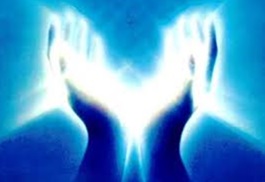
After this introductory remark let us turn to the theme of this article, which lays out a jnana yoga path of knowledge. Through right understanding of name and form it wishes to reveal a vision, which is beyond name and form. This is the course pursued in the renowned Mulamadhyamakarika by Nagajurna, on whom I will partially draw in this article. Emptiness is no-thing. The eye of mind tends to see emptiness in a negating sense, as the lack of some-thing. The eye of contemplation sees emptiness in a confirming sense, as blissful self-fulfillment shining forth. Nagarjuna wants to show that the world is some-thing as seen from the perspective of the eye of mind. Seen with the eye of contemplation it is no-thing, it is blessed emptiness. He goes on to say that the appearances of the world possess only an apparent existence. They have existence only conventionally speaking, as seen with the eye of mind. Ontologically speaking, the form of the world is not some-thing. It is no-thing. The form does not exist as something, as seen by the deluded eye of mind. It exists as no-thing to be seen with the purified eye of contemplation. It has existence as emptiness to be realized as the fullness of true life. Buddha saw the emptiness of consciousness, of nirvana, of the absolute. Nagarjuna in his supreme vision rose above Buddha. He saw the emptiness of consciousness as the emptiness of form. This is a vision which the present article wishes to disclose. By drawing on the eye of mind this exposition wants to coherently show that the whole world is emptiness. It is a jnana yoga path, which, with all forms dissolved, takes us to the gate-way opening up into emptiness. For emptiness to be seen one has to step through the gate-way.

For this appropriate methods of meditation can be applied, some of which will be only briefly referred to in this article. What we are engaged in here, is a preliminary step, which wishes to logically disclose that the whole world is sunyata, is an empty fullness to be realized. It is an essential step though, which must be taken to properly evaluate the experience of emptiness. 2. Suzanne Segal's Fear of EmptinessWhen as a result of a fruitful meditation emptiness shines forth, this can create great fear, when you do not rightly appraise the experience. This may lead to a serious personal dilemma, which must be clearly avoided. Here Suzanne Segal can serve as an example, who came to be known through her book Collision with the Infinite.

After having practiced transcendental meditation for several years she took part in a training course conducted by Maharishi Mahesh Yogi to become a teacher of TM. She writes, italics added: The experiences I encountered in meditation during those months of 'rounding' were a mixture of awe-inspiring and terrifying, as I became more acquainted with the hot breath of fear as it scorched my insides and rattled my bones. Bliss had forsaken me. As soon as I closed my eyes to meditate, a great vastness would appear. The sensation of being pulled across a threshold into the infinite came more and more quickly, and I began to meditate cautiously, trying to hold myself back, fearing the moment of stepping into the emptiness of the transcendent field. I was afraid that I would never come back and that someone would find my body sitting on the bed days later, empty. 'If I could only take someone with me,' I thought to myself, 'then it wouldn't be so scary.' I found it hard to believe that this was really a normal part of meditation, and the intensity of the experience made me worry that I might be in some kind of danger. I resolved to ask Maharishi about it, but I didn't get to pose the question for another year, during which time the fear grew, taking up residence in my guts like some uncontrollable parasite. As far as I knew, I was the only one wrestling with fear or having such experiences, which only increased my distress." (2009:17) Suzanne Segal could have made the blissful experience of emptiness, if she had been duly prepared for the experience. Emptiness, the dissolution of the false I, however, was not part of Maharishi's training program. So instead of making the blissful experience she was struck by fear, which scorched her insides and rattled her bones. The lighting up of Emptiness is the natural result of the meditative process. In the normal waking consciousness, the experience of consciousness, which is pure emptiness, is covered up by an incessant stream of thoughts. In the practice of TM you sit down to repeat a mantra like I was given when initiated into transcendental meditation in 1969. This was the secret mantra Aing Namah, which I am glad to reveal on this Page. For the TM meditator the mantra has no thought content. So while repeating the mantra consciousness becomes liberated from the process of thought. During meditation the mantra may disappear. There are two possibilities now, which may come to pass. Consciousness may turn again towards a thought. It may also happen that consciousness turns towards itself. So consciousness becomes conscious of consciousness, which is pure emptiness. As an illusory I man wants to be somebody. When emptiness shines forth man sees himself as nothing. Emptiness and the illusory I or ego are mutually exclusive. When emptiness lights up the illusory I evaporates. Now Suzanne believed to be this I or ego. So she writes: Fearing the moment of stepping into the emptiness of the transcendent field, I was afraid that I would never come back. She feared that the Suzanne she believed to be would not come back. This was for her like the fear of death, which took up residence in "her guts like some uncontrollable parasite". 3. The mask of the unreal IWhen you have truly seen that this I or ego is a fiction, the experience of emptiness does not create the fear of death to scorch your insides like in Suzanne's case. It may be seen now as eternal life blissfully lighting up. This shows that it will be wise to investigate the matter more closely. As the unreal I or no-self one is identified as this particular person, as this Greek persona or mask, who believes to be intelligent, dumb, honest, mischievous. This is a way of distinguishing oneself from all other people one comes in contact with.

Imagine that a person you respect, admire walks up to you and says: You are a big fool. In a process, which happens subconsciously, you turn the You into an I. So you say to yourself: I am a big fool, to feel angry now, depressed maybe. Half an hour later another person whom you highly esteem walks up to you and says: You are a wonderful person. The big fool is forgotten now, while you say to yourself: I am a wonderful person. Oh, how wonderful I am, you keep on repeating to yourself now. The anger, the sadness you experienced a while ago has disappeared, sunk to the subconscious ground of your being. So you are no longer aware of it. The result is that you rise and shine now in an elated, in a euphoric state of mind, until you come crushing down again. After the rise comes the fall. So we ride up and down on the ego's wave. As the unreal I or Ego we try to become a You, an object, while remaining the I who we are. When I try to be a You, I attempt to be something which I am not. This way I become alienated, estranged from my true nature. I am one party, which endeavors to be another party. So I become a distorted version of myself. This creates an inner conflict, which is the breeding ground of all the psychic suffering in the world.
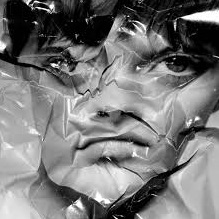
Trying to be an object, a second party, is an absurd undertaking. You cannot be anything but yourself. The object, the You I try to be exists in the other person's mind only. For myself it can have no real life. It is a mere fiction existing in my own mind. Nobody would consciously believe to be a You, to be an object to himself. So we identify in an unconscious process with the You, which exists in the mind of the other person. This way our emotions depend on the whim and mood of the people surrounding us, on the social standards they believe in to project them onto our consciousness. So we find ourselves restricted, restrained in our feelings, our actions. When you say this, they think you are great. When you do that they say you are a damn fool. We want to be respected, be loved by other people. So we adjust our actions, our thoughts to the rules and standards of the society we live in. Thus the free flow of life becomes subdued, suppressed. The result is the unreal I or ego. When the false I is gone I am nobody. So there is nobody depending on the whims of society, nobody to have any of these confining emotions of anger, grief, sadness resulting from the identification with the You. So the walls of our self-constructed prisons have disappeared now. When you truly know that the ego is an illusion, you are not trying to hold yourself back, "fearing the moment of stepping into the emptiness", which Suzanne was so desperately afraid of. You may let go, surrender, to become immersed in emptiness, with the no-self or ego consumed, absorbed by the great void. This is blissful emptiness experienced as the great liberation from the restricted person(a) you believed to be. Life is flowing freely, abundantly now. It is a blessed state. As a rule the beatific state lasts only for some time. Then the craving to be somebody emerges to make itself felt. 4. The unreal I seen as the craving to be somebodySeen in its depth the unreal I or ego is nothing but the craving to be somebody, to be this particular person, which wishes to be seen as respected, admired, loved by other people. What we must do now is to feel the craving, to become consciously aware of it. The emotions of anger, fear, grief have fallen out of pure consciousness. On a deeper level it is the craving to be somebody, which has become divorced from what we truly are. We must be consciously aware of our craving, deeply feel it, sink into it, become one with it. So the craving to be somebody disappears. So the true I, seen as pure Emptiness, lights up again. The Emptiness of the real I or Self is the free flow of life, which as an unreal I or ego goes into a state of self-contraction. There is nothing but the real I or Self, which is pure consciousness, emptiness. The Self is either in a self-contracted or in a not self-contracted state. When It is in a self-confined state we call It the unreal I, the no-self or ego. The no-self is the true Self in a self-constricted condition, locked in by the You, by the social rules, the codes of conduct the Self has identified with.
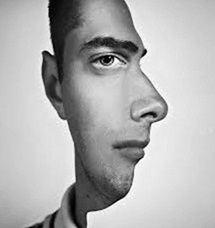
When in the self-constrained state, It remains the real I, the Self, which It is. Held captive by the norms of society It continues to live as the infinite, absolute Self, which is only in a self-constricted condition now. The experience of the true Self, which is emptiness, and the illusory I, the no-self, are mutually exclusive. When emptiness lights up the illusory I disappears. When the no-self turns up again the experience of emptiness evaporates, dies down. 5. How Maharishi Mahesh Yogi blows up the ego of his followersThe liberation from the false self or I, the state of no-self, was not part of Maharishi's training program. "Maharishi Mahesh Yogi...had never mentioned no-self in any of his teachings", writes Suzanne. (2009:78) Moreover the reading of books composed by other spiritual masters was not allowed for the prospective TM teacher. We see Maharishi had no intent to dissolve the ego of his adherents. He was much rather inclined to blow up the ego of his followers, so in this introduction to one of his siddhi courses: 'Now we will start the process of making you all Governors of the Age of Enlightenment' he said. 'Your clear transcending will be put to use to bring peace to everyone on the planet. We are heralding in the Age of Enlightenment through the effects of your hours of deep meditation. Soon the whole world will be enjoying the peace and bliss that our meditation is sending out like waves to everyone'...After describing the siddhis in some detail he gave us the exact techniques, called sutras, for five of the siddhis. One of them was the flying sutra...The next morning, the newcomers arrived on time for our first group siddhi practice... Our amazement quickly turned to hilarity when we witnessed the old-timers take off. 'Flying' wasn't really the right word for what they were doing; it bore a closer resemblance to hopping. But there they were, sitting in lotus position with their eyes closed, letting out sounds ranging from war whoops to giggles, hopping around on the foam mats looking like frogs plopping from one lily pad to another. What a sight!" (2009:26/27). This in Maharishi's teaching was designed "to bring peace to everyone on the planet". What a sight, what a peace this was sent out with giggling war whoops for the whole world to rejoice in. Maharishi's teaching was not adapted to unravel the ego of his adherents. It was well-chosen to enhance the ego of his followers, who firmly believed to be at the leading-edge, to be the avantguard of mankind heralding in the Age of Enlightenment. For this they had come from far and wide to partake in the Siddhi flying course, with waves of peace and bliss emanating from their sublime state of consciousness for all mankind to relish in. This, so we hear, was due to the Maharishi effect defined by Maharishi as the "influence of coherence and positivity in the social and natural environment generated by the practice of the TM and TM-Sidhi programs". Meanwhile Suzanne in her more silent meditations continued to be confronted with the experience of emptiness. This made her fear of death grow to unknown proportions. "As far as I knew, I was the only one wrestling with fear or having such experiences, which only increased my distress" (2009:17), she said. The flashing forth of emptiness, with the false I dissolving, is a natural outcome of the meditative process. This creates the fear of death when you believe to be the false I. I know of other meditators, who had been confronted with a similar fear due to the inappropriate teaching given by Maharishi. They were, however, implicitly instructed not to talk about their anxieties and qualms. "Maharishi taught that nothing could hurt us when we were meditating and that any experience encountered in meditation was a good experience" (2009:13), says Suzanne Segal. We see Maharishi's teaching was not concerned with fear and angst. It was dedicated to blissful enlightenment resulting from a transcendental meditation, which was always a good experience. This had to be perfectly kept in mind by the TM meditator to maintain the purity of the teaching. Although TM was marketed as a technique to improve everything from blood pressure to sex, those of us who attended the advanced courses knew that we were after only one thing - enlightenment. We were committed each in our own way to finding that elusive yet utterly fulfilling experience of Unity consciousness, and we proceeded on faith that we would get it if we did everything Maharishi instructed us to do. (2009:21) 6. Smoothly gliding to Maharishi's honeypot of enlightenmentFor blessed enlightenment to be realized you must not be given to fear and angst. What was provided for in Maharishi's teaching were good, were positive feelings only. So the prospective teacher of TM was not inclined to talk to fellow meditators about adverse emotions arising as a result of the meditative process. Any experience encountered in meditation was a good experience, so the instruction of Maharishi Mahesh Yogi.

Maharishi had promised that you could smoothly glide first to Cosmic consciousness (CC), then God consciousness, finally to Unity Consciousness to become immersed in the ultimate state of blissful enlightenment. In his Transcendental Misconceptions R. D. Scott comments:
No proof is ever given, no proof is ever demanded. For those who get absorbed into this miasma of pseudospirituality, the desire for CC or higher is pervasive and, for many, all-consuming. The only solution to this unsatisfied hunger is to obey the words of the 'master', who says that the quickest way to CC is to teach TM. The puja [initiation ceremony] is the 'highway', Maharishi claims. It's a nonstop expressway to cosmic consciousness. For example, we find this statement on page 2 in the Introduction to The Holy Tradition: 'When the initiator [the teacher] is leading the new initiate into Transcendental Consciousness, he himself is rising into Cosmic Consciousness.' When you 'buy into' TM, you throw your discrimination away and enter a pervasive mood around the movement that causes an automatic 'Good' button to light up in your head - whether meditator or teacher whenever you hear CC mentioned." All anger and fear is cast aside while "you find you're headed toward the honeypot of CC with many other fellow idealists. And if you continue long enough, you eventually graduate to 'exponent of reality' as I did, leading still more people into Maharishi's spiritual trap. (1978:82) 7. The prison of Maharishi's conceptual frame-workSuzanne Segal was determined to become a teacher of TM to see herself speed ahead on the glorious expressway leading to the heavenly CC honeypot. So she ran away from the fear and terror, which had befallen her, while she engaged more deeply in the meditative process. This did not prevent her from observing what happened in the TM environment, in which she was embedded. She writes: The long hours of meditation wreaked havoc with some people's memories, but we were for the most part a young and resilient group capable of withstanding the multileveled assault on our mental faculties. There were a few, however, who were unable to tolerate the intensity, and I witnessed several painful encounters between these individuals and the course leaders, who had determined that anyone who was exhibiting too many symptoms of unstressing would be considered an inappropriate candidate to complete teacher training and be dismissed from the course. Rising anger and fear was interpreted as a severe sign of unstressing. This also applied to several other experiences, which were not provided for in Maharishi's teaching program. So "one woman who began to hear the 'voices of the angels' was eventually asked to leave the course." Hearing the voices of angels was not part of Maharishi's TM program. So the woman was first kept isolated from other meditators, which was a necessary precaution to maintain the purity of the teaching. She became furious and demanded to speak with Maharishi privately about the decision. Her request was denied, and a guard was posted at her door to prevent her from leaving her room or speaking with anyone from the course. Screams, shouts, and hysterical crying could be heard emanating from her room, but we never saw her again. At the end of the course, just before Maharishi arrived, one young man began exhibiting severe paranoia. He haunted the hallways of the hotel, springing from doorways to rant about communist plots, spy telescopes trained on his window, and bugging devices in his room...Arrangements were soon made for the young man's departure. "Frankly, we all worried about him and secretly prayed that nothing like that would happen to us", writes Suzanne with all the fear and anxiety rising in her. We never talked much among ourselves about our own unstressing because we all seemed to have developed an intuitive fearfulness about being overheard, taken out of context, or reported to the course leaders. The realization eventually dawned on us that an atmosphere of mistrust was brewing around us and edging ever closer, even though no one allowed themselves to admit the seriousness of the situation. (2009:15/16) So Suzanne was careful to cover up her fear and terror, above all in the presence of her superiors, not to be expelled from the teacher training program, which - despite all adverse circumstances - she still trusted to be the glorious expressway to enlightenment. Suzanne kept on running away from the fear, the terror, which had befallen her. This was a way of holding on to her angst. To dissolve one's fear, one must not try to cast it aside. One must accept the feeling of anxiety, go into it, become one with it. So the obstructive emotion disintegrates. Suzanne instead attempted to do away with the disagreeable sensation. While trying to throw out the feeling of fear she held on to it. The result was that the sensation of fear, of terror, intensified. "I resolved to ask Maharishi about it", she writes, "but I didn't get to pose the question for another year, during which time the fear grew, taking up residence in my guts like some uncontrollable parasite." (2009:17)
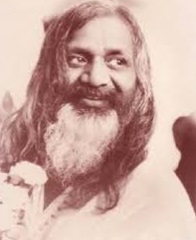
When the year had elapsed, "I was finally able to ask Maharishi my question about fear, when he came to see us at the end of our course." So Suzanne - in spite of the oppressive TM programming she had undergone - had maintained enough integrity to stand up to pose the unpleasant question. So she began: Maharishi, I must ask you about an experience that I've been bothered with for over a year. Whenever I have clear experiences of tran-scending, I'm attacked by an overwhelming fear that makes me feel like I'm going to die right there if I don't stop meditating. Maharishi broke into peals of laughter, a response I had not anticipated. 'Don't worry about the fear,' he said, still laughing. 'It's just the body holding on to the world. You must let go of the world to transcend, but the body becomes afraid because it thinks the world is all there is. You must not listen to the fear of the body--just let go.' (2009:32) The body is not afraid of dying. To be afraid of death you must be able to imagine the process of dying. For this you must have a mental idea of death and life. Otherwise you cannot be afraid of dying. An animal has a body like man has. Unlike man it cannot conceive of an abstract concept like life and death. So also the more highly evolved chimpanzee will not be besieged with the fear of death, like Suzanne was. Unable to think of death there is no way for the animal to be afraid of death like the human being is. Not the body was afraid of death. Suzanne was afraid of dying. When emptiness began to light up the false I was on the point of dying. So Suzanne, who believed to be this I, was struck by the fear of death. As this false I she was also identified with the body. So death meant for her the death of the body. Thus when emptiness began to shine up she was afraid that the life of the body would become extinct. So Suzanne was afraid of being annihilated in her physical existence. "You must not listen to the fear of the body--just let go", said Maharishi laughing himself silly, as silly as his reply was. He meant that Suzanne did not have this fear. He asserted that the body has this fear. So he implied that Suzanne was not the body. Then he told Suzanne to let go of the fear. So Suzanne was instructed to drop the fear, which not she herself, but the body had. Suzanne, who was identified with the body, believed to be the body. To follow Maharishi's instructions she first had to persuade herself that she is not this physical form. Next she had to tell herself that it is not she herself, but the body which has the fear. Then in the final analysis she had to abandon the fear which not she, but the body had. Suzanne Segal was perceptive, imaginative enough not to blindly follow Maharishi's confused instructions. What remained was the fear of death, which she struggled to escape. You do not dissolve your fear by trying to cast it away. This leads to an intensification of the fear you have. A state of fear, anger, grief is a condition which has become alienated from the pure consciousness which you are. The state can only endure as divorced from your true nature. This is the only way for these adverse emotions to live on. To be liberated from the unpleasant condition you must be aware of it. You must deeply accept it, sink into it. So these adverse emotions can become one with the stream of consciousness, which you are. So they can dissolve.

Suzanne, however, firmly held on to these thoughts of fear, while she desperately tried to throw them out. The result was that her fear intensified to "unknown proportions", as she observed. Suzanne Segal later participated in another three month course. It took place, so we are informed, in the hotel Pratjali in Arosa, The hotel was equipped with a grand ballroom, which had been turned into a cavernous siddhi arena. It echoed with the screams and the yelps of the group and sent them reverberating through the entire hotel. We spent about six hours a day in our rooms doing rounds and another three hours in the large group doing siddhis. The cacophony was ear-splitting. So the siddhi courses were starting to take their toll on my peace of mind, making me feel agitated rather than blissful. At the end of the course I could not wait to leave Arosa, never to return to the madhouse that the TM organization had become. I wanted to flee from the prison of the conceptual framework I had adopted in the confines of Maharishi's world, flee and not look back, hoping the next chapter would bring what I had truly sought. (2009:33) 8. Suzanne Segal's Collision with EmptinessFor the next chapter of her life Suzanne returned to the United States, California, which for her seemed like the obvious destination "after years of cloistered living". She now had the good fortune to engage in a "freely explored life with enthusiasm and joy". (34) Later she moved to Paris, where she got married to Claude. She writes: A year had gone by, and I found that I was reluctant to resume meditating, because I feared that Claude - and, I imagined, all Parisians - would disapprove. I was also angry at Maharishi, deeply disappointed in the spiritual world he represented, hurt that I hadn't found the enlightenment he had promised I would attain in six to eight years. (41) "It was in the springtime that it happened", so we hear. "I was returning home to my apartment", writes Suzanne. I had decided to take a bus instead of the metro, in order to enjoy the lovely weather...As the bus approached...I suddenly felt...cut off from the scene before me....What I had previously called 'me' was forcefully pushed out of its usual location inside me." (48/49) It was forcibly pushed out, because Suzanne resisted the process, in which the 'me' disappeared. So for her it felt like a Collision with the Infinite, as portrayed in the title of her widely read book, in which she writes: Incapable of making sense of this state, the mind alternated between racing wildly in an attempt to put 'me' back together and shutting down completely. (51) The whole thing was nightmarish beyond belief. (52) There was the sense of being on an edge of sorts, a boundary between existing and not existing, and the mind believed that if it did not maintain the thought of existence, existence itself would cease. (53) The personal self was gone, yet here was a body and a mind that still existed empty of anyone who occupied them. (54) In an attempt to understand what had occurred, the mind began working overtime, generating endless questions, all unanswerable. Who thought? Who felt? Who was afraid?...Why did this body continue? Who was living? (55) The more baffled the mind became, the greater the fear. By this time the body had locked into a pitch of terror that generated continuous shaking in the extremities and copious sweating. (56)

We see Suzanne kept up a severe struggle to hold on to the thought of her existence. It was a battle and strife, in which she persevered, because she believed that her very life depended on it. When there was too much outer stimulation in her daily life she was unable to maintain the thought of existence. These were the times, in which an appalling fright of annihilation would arise. In this fear everything appeared to be dissolving right in front of her eyes. She writes: Constantly emptiness was everywhere, seeping through the pores of every face I gazed upon, flowing through the crevices of seemingly solid objects. The body, mind, speech, thoughts, and emotions were all empty; they had no ownership, no person behind them. I was utterly bereft of all my previous notions of reality. (63) It seemed so unimaginable that everything would continue as before now that it was all seen to be empty of what it had previously been full. But continue it did just as before - and in most cases even better. (65) The process of growing accustomed to having no individual self continued to unfold...Since the mind had already judged the entire shift of consciousness to be negative, there was little room for the positive to be perceived. In those rare moments when the emptiness appeared to move to the background, even slightly, the mind seized the opportunity to note a return to a 'normal' state of awareness. This shifting of emptiness to a background position was the only thing that qualified as positive to the mind. The mind seemed driven to understand what had happened, but its search for answers within the mind itself was not yielding results. (87) Here is the answer, which Suzanne did not find in her never-ending quest revolving around the emptiness of no-self. What had happened at the bus stop was a Collision with the Infinite, in which, what she called the Self, had disappeared, to leave her with a no-self. As she was certain to be this Self or I, she yearned for the I to return.
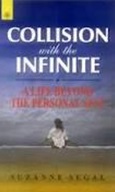
In reality the I, which Suzanne believed to be, had not really dissolved. Identified as an I, you believe to be somebody. When the I is gone there is nobody. So there is nobody left to be afraid. Suzanne was panic-stricken after the bus-stop incident. So the false I was still there. It had merely receded from its usual abode. The result was that Suzanne was no longer aware of it. What we have now is a hidden I or ego. Unrecognized it exerted itself in its yearning to be recognized. Now Suzanne in her struggle did not find anything, which resembled the I she was looking for. This is what created the feeling of terror, the fear of annihilation, in her mind. Before the bus-stop incident she believed to be this I or ego. That was a positive illusion she held on to, which gave her this feeling of security. This is a feeling we all indulge in, as long as we are identified as the false I. The illusory I nourishes on this sense of security. It is the ego's life-blood. It is an illusory sense of security though, stemming from an illusory I. This was the positive illusion Suzanne indulged in before the bus-stop incident. After the incident a negative illusion arose. When the I had disappeared, all sense of security was gone. Suzanne wanted to feel safe and sound again. So she languished for this sense of security, for this I, to return. As she could find this I nowhere, a violent fear arose, which scorched her insides. This was the negative illusion in which she indulged now, while she kept on yearning for this I to appear again. For this craving to disappear, one must accept, deeply feel the yearning, become one with it. So it can dissolve, as we have seen. For this to happen you must know that the I you covet, is a false, an illusory I. Otherwise there is no motivation for you to give up the craving. So you will not be inclined to accept the craving, to feel it, to sink into it to have it dissolved. Suzanne had fallen prey to Maharishi's ill-conceived teaching. Thus she mistook the false I for the real I. So she pined for this emptiness to disappear, for this I-ground to reappear, on which her life had been built. She writes: The mind's hypervigilance was exhausting. Because it was constantly engaged in rejectng the experience of emptiness, there was very little attention available for anything else. My life was filled with seeing no-self, fearing no-self, judging no-self, worrying about no-self, and raising questions about no-self. (86) While always seeing no-self she was always looking out for the Self to return. What she was engaged in, was a self-defeating endeavor. The very longing for the I to return prevented the I from turning up again. Let us look into the matter more closely. While longing for the I to reappear Suzanne made the I an object of thought. There is, however, no object, which is the I. The true I, which is consciousness/emptiness, is beyond thought. So it cannot be an object of thought. In the normal waking state consciousness/emptiness, the true I, identifies with the You, with the predicates revolving around the You. In an unconscious process it attaches itself to these attributes of being intelligent, dumb, honest, reliable. So the Self becomes trapped in a state of self-contraction, which is the condition of the illusory I. The true Self, which is consciousness/emptiness, is beyond subject and object. When in the state of the illusory I, it does not become an object. It remains the Self which It is. It is only in a self-confined condition now, as we have seen. In our exploration of the subject we speak of the I. This does not mean that there is this object of the I. Not the I composes this essay. I write these lines. We only speak of the I to abide by a linguistic convention. It is a mere manner of speaking, which Suzanne did not see. So in her quest she looked out for the I, which for her was a reality. So she looked at an object, at some-thing which does not exist. The result was that she looked at no-thing, at the emptiness, from which she tried to escape. So in her quest she became more deeply immersed in the emptiness, which she tried to evade. Constantly trying to grasp the I, which had disappeared, she held on to the emptiness, in which she had become immersed.
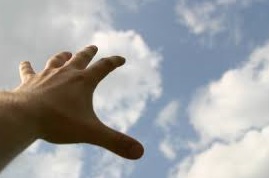
In the book Stranger to My Self: Inside Depersonalization; the Hidden Epidemic the author writes: As a young girl, Segal would sometimes repeat her own name in her head over and over. Eventually, "a threshold was crossed and the identity, as that name, broke like a ship released suddenly from its mooring to float untethered on the ocean waves...Vastness appeared...There was no person to whom that name referred, no identity as that name. No one. (Wikipedia, the free encyclopedia) You can employ this as a meditative exercise for the false I to disappear. For this you sit down, firm and relaxed, to repeat I, I, I. Instead you can repeat your name, which stands for what you call I. While doing this you make, what you call I, an object of consciousness. Now what you call I, is not an object to be perceived. It is the true I or Self, which is consciousness/emptiness in a self-contracted state. While repeating I you constantly view I as an object. This is an object, which does not exist. So the I you are focused on turns into a meaningless syllable, into an empty letter I, which represents no-thing.

So you look at no-thing, at emptiness. So (the) I disappears. What remains is no-I, no-self, which is emptiness. This is what Segal practiced in her childhood. So in her meditation what she called I or Suzanne disappeared. At the bus-stop she did not engage in any meditative practice. What she called I disappeared on its own account. Now Segal wanted this I, this Suzanne, to return. So again she looked at an object of an I, which does not exist. Thus she unknowingly applied a technique not for the I to recede, but to abide in a state of emptiness, in which the I had withdrawn. Let us view the matter from the perspective of the scientist engaged in consciousness studies. Identified as an I, consciousness/emptiness is in a state of self-contraction, so we have seen. It is a state, in which no one doubts that consciousness is there, is present. So everyone when asked would say: "When I was in deep sleep I was not conscious. Now I am awake. So I am conscious." Thus everyone is firmly convinced that consciousness exists. So also our scientist is fully persuaded of the existence of consciousness. He does not, however, know what this consciousness is, because he has never seen It. So he sets out to investigate the nature of a consciousness, which he has never seen. His ongoing explorations are based on the assumption that consciousness, like the other phenomena of this world, can be made an object of exploration.
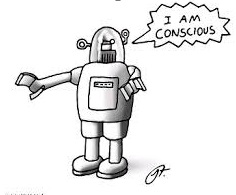
Consciousness/emptiness is what You Are, and You Are not an object of yourself. Thus science is engaged in exploring an object, which does not exist. It explores what is not to be explored. In its ongoing research it looks for an object of consciousness, which does not exist, like Suzanne was looking for an object of I, which has no existence. So science unknowingly has become entangled in a metaphysical project. In this vast array of consciousness studies it has always been occupied with exploring some-ting, which is no-thing. So science keeps on turning around in a viscious circle "like a dog trying to bite its own tail", as portrayed in Part I: 3. Science tries to find consciousness where no-thing can be found Consciousness cannot be an object of exploration. It is no-thing, It is an emptiness, which is either in a contracted or in a non-contracted state. No matter what state It is in, consciousness is emptiness, thus emptied of all thought. It would be interesting to probe more deeply into the subject in the light of The Disneyland of Consciousness, which contains a response of Andrea & David Lane to Don Salmon's Shaving Science with Ockham's Razor: What, if anything, does science tell us about reality? This would entail a more in depth exploration of the subject. Also without it this essay is getting longer than I had expected. So let us stay with Suzanne Segal for the moment, who tried to grasp what had happened at the bus-stop. 9. Suzanne's state of no-self diagnosed as a mental disorderSuzanne's desperate search for an answer did not yield any results, as we have seen. Finally the notion arose that someone well acquainted with the intricacies of the human psychology might be able to explain this unusual phenomenon. After all Suzanne was haunted by the fear of insanity. So for her psychotherapy now seemed to be the only place to turn to. "From the occurrence of the emptiness of individual self in the spring of 1982...I had consulted with ten psychotherapists (99)", she writes. We then read that none of the therapists had done anything but substantiate her fears. All of them mistook he illusory I for a real I, from which all our thoughts and actions spring. So the state of no-self, in which Suzanne found herself, was invariably diagnosed as a dissociative disorder, as a condition of de-personalization, de-realization, and dissociation. (93) The experiences in therapy took Suzanne through the end of her graduate training at the Wright Institute, where she obtained a Ph D. in psychology. "I was being trained", Suzan states, "to practice psychotherapy according to the Freudian 'blank screen' model", a "traditional psychotherapy", which "seems to be based on a primordial fear of mystery, and this fear creates the tendency to reduce, interpret, pathologize all manifestations of consciousness that do not fit the cultural norm." (102/103) As I neared the end of my training it became clear that I was looking in the wrong place to understand the experience of no-self. (104) 10. The emptiness of the Buddhist no-selfIn the spring of 1992 one year after finishing graduate school - writes Suzanne - I began to seek a spiritual perspective on the emptiness of personal self. I read voraciously, prowling bookstores endlessly for anything that might shed light on my experience. These efforts paid off handsomely when I discovered Buddhism. There were entire volumes written about anatta (no-self) and shunyata (emptiness), page after page devoted to describing, discussing, and investigating the experience I had lived with for the past ten years. I read everything I could find. lt was amazing that I had never discovered any of this material before...In Buddhist circles, I learned, one is not met with stares of confusion and horror when describing no-self. In fact, I was getting the impression that not only was my experience considered a positive one, it was seen as the goal of every person who embarked on the Buddhist path. One aspect of my experience that Buddhism was particularly helpful in explaining was that although individual identity had dropped away, all the personality functions remained completely intact. Now, however, those functions floated in a vastness that referred to no one. All the same experiences still happened, there just wasn't a 'me' to whom they were happening. And the appropriate responses just happened as well, arising out of and then subsiding into themselves. Everything appeared and disappeared on the broad screen of the infinite--interactions, emotions, talk, actions, without an individual self to direct action and speech. (108/109) 11. A Buddhist misconception of the individual selfWhat in the normal waking state is referred to as I or me is an illusion. This the Buddhist texts see very clearly. They mistakenly see, however, this false I or self as an individual self. Identified as an I we believe to be some-body, to be this false person(a) or mask. There is no who, you, or me, however. Not I perceive, consciousness/emptiness, It perceives. Now comes something, which Buddhism does not see. There is not just consciousness/emptiness that sees. There is consciousness individualized which perceives, which thinks. What consciousness is we cannot express in words, because it is empty of all thought. The problem is that we can neither express in human speech what the individual is. This is the Latin individuum, which means not to be divided. The individual is one. So it cannot be severed into two, not divided into so many words. There is only the one individual. So there is no other one it could be compared to. Let us take two guys, Peter and John, who are both considered to be bright, intelligent. We cannot compare Peter's intelligence to John's intelligence, because the quality of intelligence, of all other attributes referring to Peter and John, express themselves in individual uniqueness through Peter, individually, uniquely through John. The great theme of Buddhism is the individual I or Self which has to dissolve for emptiness, nirvana, to light up. This creates an erroneous understanding of self-realization. The individuality of man does not dissolve when he has reached the summit of evolution. He realizes himself as the individual soul he truly is. As the false I the individual is in a contracted state of being. When the experience of consciousness/emptiness lights up, all contraction dissolves for the individual to emancipate himself from all social conditioning.
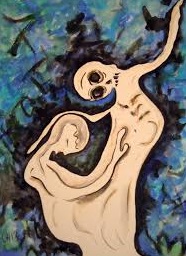
What disappears is not the individual. It is the contracted condition, which dissolves, it is the self-confinement, self-restriction, which dwindles away. The false I perishes, succumbs, while the individual human being is reborn in its true nature. When the true Self is born the individual does not dissolve like a drop of water in the ocean, to employ this well-known Buddhist metaphor. The opposite is true. The death of the false self or ego is the birth of the true self of man. So the torn, the alienated human being is reborn as the unified, the true individual he is. Ramana Maharshi and Nisargadatta are true enlightened teachers of Vedanta. They have both realized emptiness, which is pure life eternally reborn. But look how this one life shines through each of them autonomously, exclusively. Their individuality has not dissolved like a drop of water immersed in the ocean. It is the ocean which is reborn in each of them uniquely, individually.
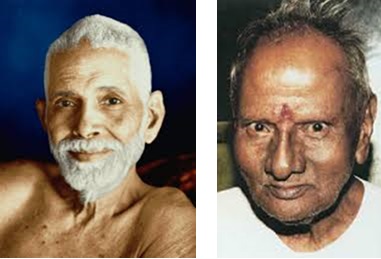 Still Buddhism saved Suzanne from the dilemma she had been entrapped in due to Maharishi's ill-conceived teaching. The Buddhist teaching unmistakably revealed to Suzanne that this I or Self, she so desperately wished to reappear, is a mere illusion. Suzanne now began contacting "spiritual teachers whose books or articles", so she writes, made mention of the emptiness of personal self." I wrote to a handful of the best-known Buddhist and Hindu teachers, describing my experiences in detail and asking for their comments. From all of them I received wonderful interesting letters filled with praise and excitement. Each in their own way made it clear that what had happened was wonderful. Each letter verified the experience as the realization of the true nature of all creation. (115) 12. Emptiness perceiving itself out of itselfSuzanne he exchanged letters especially with Gangaji, Poonjaji, Ram Dass. After a talk with Andrew Cohen she began to see that the "emptiness of a 'me' was full of exquisite infinity. This awareness was to deepen and move to the foreground radically in the next month." (123) As it turned out, the joy was to arrive all at once, crashing onto the shores of awareness suddenly and irrevocably... I was about to shift permanently into unity awareness, in which the emptiness that dominated my consciousness was seen to be the very substance of all creation. Once the secret of emptiness was revealed in this way, I began to describe it as the 'vastness'. In the midst of a particularly eventful week, I was driving north to meet some friends when I suddenly became aware that I was driving through myself. For years there had been no self at all, yet here on this road, everything was myself, and I was driving through me to arrive where I already was. In essence, I was going nowhere because I was everywhere already. The infinite emptiness I knew myself to be was now apparent as the infinite substance of everything I saw...

Everything seemed more fluid. The mountains, trees, rocks, birds, sky were all losing their differences. As I gazed about, what I saw first was how they were one; then, as a second wave of perception, I saw the distinctions. But the perception of the substance they were all made of did not occur through the physical Body. Rather, the vastness was perceiving itself out of itself at every point in itself... From that day forth 1 have had the constant experience of both moving through and being made of the 'substance'of everything. This is what is experienced first--the stuff of unity, its texture, its flavor, its substance. This nonlocalized, infinite substance can be perceived not with the eyes or ears or nose, but by the substance out of itself. When the substance of unity encounters itself, it knows itself through its own sense organ...
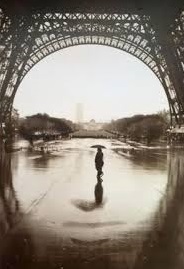
Once seen, it seemed so incredibly simple. Fear's grip now broke, and joy arose...The experience of emptiness had given up its secret. The emptiness was seen to be nothing but the very substance of everything. I finally saw what had been in front of me the whole time but had been obscured by fear... Needless to say nothing has ever been the same since. The fact that 'I' no longer existed, that there was no person any more, gave way finally and completely to the realization that there is nothing that is not myself. (129-132)
13. The experience of emptiness can be bliss or horrorThe infinite reveals itself to the mind in mysterious, unimaginable, and ungraspable ways. But the mind, by its very nature, tends to reject what it cannot grasp. Thus, when it does encounter the vastness, it makes compelling attempts to devalue it. For example, many people have said to me, 'I've experienced the vastness you're talking about, but it felt totally empty and flat. I'm not interested in going toward it again.' What they're describing is not the ungraspable experiencing itself, but rather the mind contacting the ungraspable. When the mind sees experiences as being empty of the 'someone-ness' it thought they were full of, it freaks out and begins to mount some convincing arguments for why the emptiness is totally undesirable.
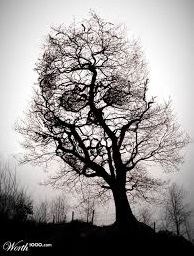
In my case the mind mounted an all-out effort to pathologize the emptiness of personal self in an attempt to get rid of it. This attempt proved unsuccessful. But many people have told me their minds were able to accomplish the task of making the emptiness appear to go away, only to be left with the memory of how unpleasant the contact with the ungraspable was for the mind. The mind then uses this memory as evidence that the emptiness must be avoided at all costs. The contact of the mind with the emptiness of no personal reference point should never be taken to be the direct experience of the vastness, which in any case does not go through the mind. Rather it is the experience of the mind's response to the vastness, and nothing more. (147/148) Mind means thought. Consciousness/emptiness is emptied of all thought. It is no thought. A thought is a thought of some-thing. Emptiness is no-thing. When the mind responds to emptiness it conjures up a thought of emptiness. So it tries to see some-thing where no-thing can be seen. Thus it makes emptiness into some-thing, which it is not. This is emptiness as a negative some-thing, which is an emptiness pathologized by the mind. So the bliss of emptiness comes to be an unpleasant, an appalling experience even, which is to be avoided at all cost.

The experience of emptiness can mean bliss or horror. Seen as devoid of all mind, of all thought, it gives birth to a pure feeling of blessedness, of beatitude. Viewed as a thought cooked up by the mind it can bring fright and terror in its train. So for the blissful experience to be made one has to go beyond the mind. This is done in a jnana yoga approach, which uses thought to dissolve all thought. It is a great method employed to prepare the seeker for the experience of blissful emptiness to light up. 14. With only a wall left there is no wall leftI would like to start out by portraying the basic idea underlying Nagarjuna's Mulamadhyamakarika.
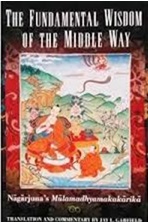
For this I would like to invite you to partake in this simple contemplative exercise, in which you take a seat in front of a white wall. While sitting there, firm and relaxed, you focus your attention on the whiteness of the wall. You continue with your meditative exercise until nothing but the whiteness of the wall remains. With all other objects wiped out in your awareness there is no-thing left to compare the wall with. So the wall, which can only exist as relative to another object, may disappear. What is left is seen as no-thing, as emptiness, viewed with the eye of contemplation, which may lighten up as a result of this meditative exercise. It is not an easy contemplative practice to start with. To make it work one would have to elaborate on it more extensively. This will not be done in this article. I have introduced the practice only to illustrate the core idea underlying this exposition. With only the wall left there is no-thing left. The objects of the world have a relative existence only. They do not come into existence independently. Our idea of the wall arises as relative to the floor, as related to something, which is not the wall. With all other objects gone the wall as such dissolves.
 The world falling to emptiness No object exists independently, exists as such. Not existing as such, all objects are emptiness. This is the idea Nagarjuna wants to convey, when he asserts
Whatever is dependently co-arisen
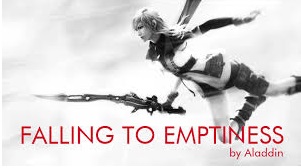
It is a truth, which does not only apply to concrete objects. It holds true for colors, for all abstract phenomena as well. In The Infinite Regress, Why Karma Theory is Nonsense David Lane refers to "Moral Systems 101", which says: If everything is painted blue, then saying one thing is blue is meaningless, since it doesn't stand apart from anything else. Color is defined by its variations. Likewise, any moral system that posits a one size fits all explanation is pointless, since morality, like color, is defined by its differences. All concepts are interrelated, they co-arise, as Nagarjuna asserts. They "have only conventional and nominal existence". Devoid of all "ontological" existence, "they have no existence at all from the standpoint of nirvana", comments Jay L. Garfield on Nagarjuna's supreme vision. That which is the element of light ... is seen to exist on account of [in relation to] darkness; that which is the element of good is seen to exist on account of bad; that which is the element of space is seen to exist on account of form. (1975:96/97) This is what David Kalupahana says in his deliberations on Nagarjuna's teaching. Without space there is no form. Let us take a cupboard, for example. With no space to be found in the drawers, there are no drawers, without drawers there is no cupboard. There is just a solid block of wood. With no space to be seen between the legs of a table, there is a mere lump of wooden material. With no space left between the individual pieces of furniture, between table and cupboard, between the other pieces of furniture, the whole living-room turns into an amorphous wooden substance. With no space to be found within an object, with no space to be perceived between objects, there are no objects to be distinguished. Without space there is no form to be identified. This holds true the other way round. Without form there is not what we call space. With all objects gone there is no-thing left for space to relate to. There is only space as such. This is not a space relatively speaking. It is pure space, which is not some-thing. It is no-thing, it is pure emptiness.

In order to see space as such you may engage in a method of meditation, in which you focus on the space only. While you do this your attention may withdraw from the surrounding objects, to become immersed in space as such. You continue in your meditative practice until nothing but space remains. This is no longer a limited space enclosed by different objects. With all objects gone it is a boundless, an unlimited space unveiling itself. While immersed in space you are still aware of the surrounding objects. You seem them, however, with a different eye now, which is the eye of contemplation lighting up. Empty space is the foreground now, while the scenery of the world keeps to the sidelines. It appears as unreal now, with trees and river, the sky above and the earth below, which exist only conventionally speaking.
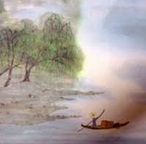
Again this is not an easy contemplative practice. To make it work we would have to look into the matter more closely, which is not the subject of this article. I wanted to illustrate once more the kernel idea underlying the ensuing exposition. For this let us turn to David Lane again, who in The Infinite Regress, Why Karma Theory is Nonsense, July 2014 asserts Nobody knows what karma ultimately is. Why? Because it is an endless circle. All actions are interconnected which leads to the previous action which leads to its previous action which ultimately leads to the original initial action which leads to the causal basis of being or matter or 'I really don't ultimately know what' which ends up where we started: not knowing

Karma seen as a theory is indeed nonsense. Every cause can be seen as an effect of some other cause. This results in an endless regress, in which every effect is a cause and vice versa. Thus there is no ultimate cause or effect of an action to be found. So every thought of karma wipes itself out, becomes extinct. What Buddhism, what Advaita try to reveal is not a theory of karma. They wish to disclose a nondual vision of karma. This cannot be debated from a dualistic stand-point, for in the ultimate vision there is no-thing to be seen with the eye of mind, no-thing to stand on linguistically speaking. What is meant in Advaita, in Buddhism can be seen with the eye of contemplation only. Karma is not seen as a theory constructed by the eye of mind. It is embedded in a nondual vision of a world, which is pure emptiness. It is an emptiness, which I AM, which YOU ARE. I am not this, not that person isolated from the world, disconnected from you as a person. I AM the emptiness, which YOU ARE, which the world is. The one cannot be seen as separate from the other. Thus whatever I do unto the world, which I AM, I do unto myself.

This is the non-dual, the timeless vision of the world. Translated into the dual, the temporal perspective of the world it says: What I have done unto you will return to me at some point of time. In a mere theory of karma the cause is relative to the effect and vice versa. The cause does not exist as such, nor does the effect. This means neither cause nor effect exist ontologically speaking. What applies to cause and effect holds true for all other ideas. In a world where everything is interrelated no-thing has an independent existence. So all notions, with the idea of karma included, fall down. The picture of a house of cards presents itself to the mind with one playing card supporting the other. You take out one card and the house of cards collapses. So the artificial edifice of concepts and symbols falls to the ground, while the world of relativity disintegrates, dissolves. What is left is pure emptiness.

The world of relativity, of samsara, has only a conventional existence. Seen ontologically it has no existence. It is pure emptiness. One can realize the ontological emptiness of the world by contemplating on the dependent, conventional existence of objects and concepts, as we have done in this Part II of the article. In Part I: Looking through Rubin's vase to envisage consciousness as emptiness I demonstrated that consciousness itself is emptiness. I also wanted to show that the world is consciousness of the world. No matter whether you think of the world in a positive or a negative sense there must be consciousness of the world you think of. Otherwise the idea of a world could not arise. The world is consciousness of the world. Consciousness is emptiness. So the world is emptiness of the world. Here is another way to reveal the emptiness of the world. I would like to show that the thought as such, the thought of the world, of any other object, is emptiness. Without a thought of the world there is no world. So the world is the thought of the world. As the thought is emptiness, the thought of the world is emptiness of the world. This means: The emptiness of the world can be demonstrated by drawing on the emptiness of consciousness. It can also be established by reverting to the nature of thought. This is what the ensuing exposition wishes to lay out. 15. The emptiness of thoughtTo have a thought we must think. To think is a verb. A verb implies an activity. An activity happens in time. With no time there is no activity unfolding. With no activity enrolling there is no time involved. As thinking a thought means an activity, thinking happens in time, which is the general belief upheld in our linguistic community. I would like to show that this is a mistaken view, that there is no time entailed in thinking a thought. You doubt this? You firmly believe that thinking a thought is an activity, which takes time? Well, we shall see. To investigate the matter more closely let us first look at an activity, which entails a temporal process. For this we will observe a person who walks the distance of one mile. He starts at point A to end his journey at point B. After 9 minutes 12 seconds he has covered half a mile. It takes him another 9 minutes 45 seconds to reach point B as the final destination of his one mile trip. Now I will ask you to think a simple thought, which I will name. You will find it spelt out on this sheet of paper. You are invited to look at the temporal process involved in thinking the concept. In the end I will ask you how much time it took to think the thought I mentioned. For the experiment to be conducted you may consult a stop watch. If you have none at your disposal look at the second hand of your wrist watch. Now here comes the concept which I want you to think. The name of the thought is: a mile. You have thought a mile now? You also looked at the second-hand of your watch to see how much time it took to think the thought? So tell me: How much time has elapsed from the beginning to the end of the thought-process? Now here is the answer to the puzzling question. There was no time involved at all. When I ask you to think a mile you have already thought a mile. Otherwise you would not know of the mile you were supposed to think. To measure a process you must know the content of the process to be determined. There is no other way for you to identify the process, which is to be assessed. No matter whether the walking of a mile, the construction of a table, the cooking of a meal is concerned, we always have a content-related process, which has a beginning and an end. So the temporal length of the process can be measured. In the case of thinking a mile, a table, a meal there is no process involved. To think a mile, to think some other thought, you must have thought the thought. Otherwise you would not know of the thought you were supposed to think. To understand what I say you must have thought what I say. There is no other way for you to comprehend the words, the phrase, which I uttered. It does not take any time to think a concept like mile, table or meal. It takes no time, because there is no activity involved. There is no beginning, no end of a process to be registered. There is no point in time where a thought starts and where a thought ends. To think is a verb, which, so goes the general understanding, implies an activity. This entails a temporal process, which begins, endures for a while, and then ends. A thought, however, whatever its content may be, has no beginning, no end. So there is no activity, no process involved. You think a thought only grammatically, conventionally speaking. Seen ontologically thinking a thought means having thought a thought. Thinking is an activity for us. So we believe that thinking a thought happens in time. We hold this belief, because we have become duped by our grammar, deceived by our conventions of speech. Walking is an activity, which involves a temporal process. First you walk half a mile, then two thirds of a mile, finally you cover the complete distance of a mile. When you think a mile you do not first think half of the concept, then two thirds, finally the complete concept of a mile. There is no way for you to think 50 % of a table, 75 % of a meal. There is nothing like half, like three quarters of a thought. To think a thought you must have thought the thought. The thought, also etymologically speaking, is something that has been thought. Here the American language gives a hint. The verb to walk resonates in the noun spelt out as the walk. There is no noun reflecting the verb to think. No noun exists, which is named the think. The proper noun is the thought, which is the past participle of to think. The same applies to the French language. La pens�e, which denotes the thought, is the past participle of penser, which means to think. Our thoughts are not of the presence, as indicated by the name of thought. A thought is something, which has been thought. A past at one time has been the presence. A thought, whatever its content may be, has been thought. So it has never been present. A past, which has never been a presence, is not a past. So there is no past thought. Neither is there a present nor a future thought. What we call to think does not take place in time. There is no place for a thought to be found. No time and place is there for a thinking to occur. There is a place and a time for a plant, an animal, a human being to unfold. What unfolds, evolves, will dwindle away, decay one day. So it ceases to exist. A thought does not decay or wither away, because it has never existed. It exists only conventionally speaking. Seen ontologically it has no existence. It is pure emptiness.
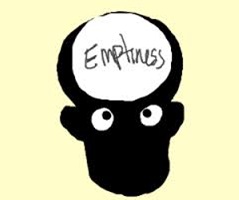
We speak of a thought, which comes, emerges, arises. A thought, so goes our speech, lasts, continues, endures. We point to a thought, which passes, goes, dissolves. All this implies an activity, a process, which happens in time. There is, however, no action to be seen. There is only an action linguistically speaking. In real life there is no process unrolling. A thought is consciousness of a thought. As consciousness is emptiness, a thought is emptiness of a thought. Now the thought, taken by itself, is emptiness, as we have seen. So the thought, which is consciousness of a thought, is consciousness of emptiness. It makes no difference whether we consider the matter from the perspective of consciousness, which is emptiness, or the thought, which is emptiness. There is always emptiness to be seen. Regardless whether we look at the world as consciousness of the world or as a thought of the world, there is always emptiness of the world unveiling itself. The world exists only conventionally speaking. Seen ontologically it has no existence. In Part I: Looking through Rubin's vase to envisage consciousness as emptiness I tried to show that consciousness as such is emptiness. You can only be conscious of one thing at a time. If consciousness as such were consciousness of something, nothing new could arise in consciousness. So consciousness as such must be pure emptiness. In my deliberations on the subject I relied on the eye of mind, on the faculty of reasoning, to demonstrate the emptiness of consciousness. So we can employ our power of discernment to arrive at a correct understanding of the nature of consciousness. This is a necessary step to be taken to avoid the spiritual disaster, which lies in a false interpretation of emptiness. This can lead, so we have seen, to a rejection of an experience, which, when rightly appraised, means blissful self-liberation. When a false interpretation leads you to reject, rebuff emptiness, emptiness turns into a buffer to have you rebuffed, rebuked. Emptiness has become a bumper, a bulwark produced in your own imagination. So you become rejected, repelled by your own fanciful creation. This is the karma, which you fabricated in your own mind. I hope David Lane does not mind. Now all this happens subconsciously. Suzanne Segal had become a victim of Maharishi's ill-conceived teaching. So she became unknowingly entangled in a process, which we brought into conscious awareness to have it uncovered, dissolved. Thus an appropriate understanding is a necessary step, which cannot be dispensed with. A proper insight deeply embraced can itself lead to an inner opening for blissful emptiness to light up. If it does not happen this way one can engage in a proper meditation for the experience of emptiness to shine forth. Here is a simple practice of contemplation born from my own imagination, which I would like to present. Maybe you would like to try out this method to see how it suits you in your own liberating approach. Just keep sitting where you are, firm and relaxed. Let the breath flow in and out, normally, regularly. While you are sitting there thoughts will come and go, linguistically speaking I mean. You did not look out for a particular thought to appear in your mind. You did not say to yourself: Now I would like to engage in this thought, which I selected from the array of thoughts, which are at my disposal. There is nothing you did to provoke a particular thought. The thought comes on its own account. Not you think, there is a thinking going on. Not I think, it thinks, we must correctly say. Metaphorically speaking this is like an unwanted visitor, who came to settle down in your living-room. You did not ask the fellow to pay you a visit. Unnoticed he came in through the back-door of your house. There he is now, comfortably established in your domicile. This is to serve as a likeness for your thoughts, which come unwanted, conventionally speaking again. Unnoticed they cross the doorstep to your consciousness to establish themselves in your mind's residence. This is something you do not want to put up with any more. You are decided not to let the next thought come in unobserved. So from now on you watch out closely. The next thought you want to spot, to detect. You want to clearly see the thought before it crosses the doorstep to your consciousness. So you acutely, wakefully look out for the next thought to show up. You are like a cat now sitting in front of a mouse hole waiting for the wanted mouse to appear. So you sit there, keenly, alertly, looking out for the next thought to make its appearance.
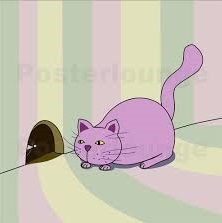
While you engage in this meditative practice thoughts may enter your mind unobserved. When you register that thoughts have crossed your mind again, there is no reason to worry. You just calmly return to your practice waiting for the next thought to arise. Now have you succeeded in your task? Have you seen a thought arise? Have you observed how it entered your consciousness to depart again? Now here is the answer. The reply to the question is a plain NO. As long as you look for a thought to arise, there is no-thing to be seen. We looked into the issue more deeply, investigating it more closely. So we realized that there is no thought present. A thought is what has been thought. Thus we know now: There is no thought to be seen. There is no thought appearing as a welcome guest in our mind's residence, no thought departing from our domicile as an unwanted visitor. Neither elaborately dressed up nor plain and naked is there a thought to be seen. When you wait for a thought to come, you look for a thought, which does not exist. What reveals itself to your vision now is totally emptied of all thought. It is no-thing to be seen. While you sit there alertly, wakefully waiting for a thought to come, you are bound to see no-thing. Liberated from the obstructing stream of thoughts you become immersed in a state of no-thought, of no-mind. In the normal waking state consciousness is covered up by an ongoing process of thoughts flowing through your mind. While occupied with a thought consciousness cannot become conscious of consciousness. Due to your contemplative practice all thoughts have disappeared now. So the impediment for consciousness to see itself has been dissolved, released. So consciousness has been set free to become conscious of itself, which is a state of pure bliss. Here we have a method for our own true nature to be revealed, which is consciousness/emptiness. So we wake up from the normal waking state imbued with a seeing which sees itself. The former waking state appears like a dream now, in which you saw yourself as what you are not. As this persona or mask you saw yourself sunk in your reveries. Awakened from your fantasy you truly see yourself now as what YOU ARE. And what are you? The answer is: YOU ARE THAT. Yes, THAT IS what YOU ARE.
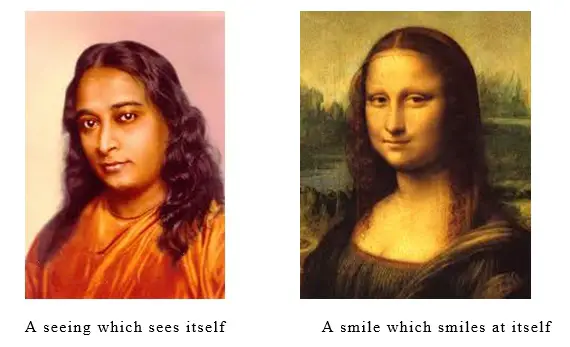 16. The emptiness of perceptionWe have dealt with the nature of thought. The outcome of our deliberations was that the thought is pure emptiness. Let us turn now from the thought of the world to the perception of the world. I would like to show that the perception of the world, of all objects to be found in it, is also emptiness. Let us take a table, for example. You think what is standing in front of you is a table. Now without a notion of a table there is not a table to be seen for you or anyone else. The table is a concept of a table. The concept is not standing in front of you. It is nowhere to be found, neither in your living-room nor anywhere else in this big, wide world. Let us imagine someone coming from a primitive civilization, in which what we call a table does not exist. People in this country sit on the floor, to have their meals, for example. Let us assume a person brought up in this culture enters your living-room. Looking at what we call a table he wonders: What kind of object is this? This is the question he asks himself, for what he sees is not a table. What he views is an item unknown to him. A six month old babe living in our culture does not see a table either, because at this tender age language has not been born. Nor does our babe see an object standing in front of him. For this our baby boy must have an idea of one item as distinguished from another item. This again requires a rudimentary knowledge of language, which our babe does not have. The infant is endowed with a normal eye-sight. For him there is, however, no perception of one article as distinguished from another article. There is perception only with no distinctions to be made. Now a normal adult brought up in our culture sees a table, in his living-room, for example. There is, however, no real table to be found. If the table had a real existence, our friend from the no-table culture, the 6 month old infant in our society, would also see a table. What they view, however, is not a table standing in front of them. For them there is no table to be seen, because the table is a mere concept existing in our mind, which we unknowingly project into a world perceived. Unaware of the process of projection we believe that the table which exists in our mind is standing there in front of us. For this let us return to Emptiness, Part I with the picture of Rubin's vase included in the article. The painting can be seen as either a vase or as two faces. There are, however, not two faces as such, nor is there a vase as such incorporated in our design. If faces and vase existed as such, there would always be a vase and two faces to be seen. This, however, is not the case. At one time the onlooker sees a vase, another time she sees two faces. For someone not acquainted with what we call a vase, there would not be a vase to be seen. There would always be two faces to be viewed. The vase does not exist out there portrayed on a piece of paper, nor is it standing on a table in front of us. There is merely a thought of a vase, which exists in our mind only. This is a thought, which is projected onto an object perceived. This does not occur in a conscious process. The thought is not deliberately attached to an object of this world. What we view as a vase is a thought subconsciously projected. You turn your head and what you see is a vase standing in front of you. What you perceive is seen instantaneously as a vase. You do not consciously attach the concept of a vase to the object perceived. The process of projection becomes only obvious when it takes some time to identify the item perceived. Let us say what you perceive is seen as a tree standing in front of you. This happens automatically so. There is no conscious act involved in identifying the object perceived as a tree. Moreover you view the tree as a conifer tree, which again happens instantaneously so. Then you ask yourself: What kind of conifer tree is this? Is this a pine or is it a fir tree, which I see? You look more closely now to realize that the needles of the tree are attached to its branches in clusters. Oh yes, I know, this is a pine tree, you say to yourself now, remembering maybe what you learned in biology class. In this case it becomes obvious, that first there is the idea of a pine tree in your mind, then in a next step you assign the thought of a pine tree to the object perceived. We see the idea of a pine tree does not exist in a world out there. It exists in our mind only, to be projected onto an object of this world. What happens in the example of a pine tree occurs in the case of a table, a vase. In the former case an effort is made to have the object properly identified. In the latter case the classifying process happens instantaneously. The fact remains that there is always a concept in our mind projected onto the outer world. No matter whether we have to do with a fir, a pine tree, a table or a vase, there is a thought, which exists in our mind only to be transferred to an object perceived. This means that the word does not exist out there. It exists in us as an idea of the world, which we have.
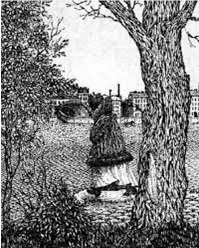
As long as we are not aware of the projecting process we are persuaded that there is a real pine or fir tree, a real table or vase existing in an outer world. We do not realize that the concept exists in our mind only. Now when we say that the concept exists in our mind we do this to abide by our conventions of speech. It is a way of speaking we must uphold to communicate with each other. In reality the thought of the table, so we have seen, does not exist. The thought is what has been thought. The projection is what has been projected. It is always gone, it is past, extinct. There is no process of thought, no process of projection going on in the presence. What is conventionally seen as a thought (projected), is ontologically seen as not existing. Rightly considered there is not a past thought even. A past implies a presence, which has past. What has been thought has always been thought. There has never been a present thought or thinking. The thought was past, was gone from its very beginning. It was always extinct, empty. The table, which we see, is a thought of a table. As the thought is empty, what we see is an emptiness of a table. The table has an existence conventionally speaking only. Seen ontologically it does not exist. It is pure emptiness. What truly exists is emptiness, which is the Sanskrit sunyata. This is a fullness, which is life eternal. The eye of mind sees a tree. Relying on the faculty of understanding it knows that the tree lives for a while and then decays. The eye of contemplation does not have a mere understanding of life. It sees sunyata, which is the one life. So It says: The life of the tree is my life, which is your life. The tree seen as pure life is experienced much more vividly than the tree seen with the eye of mind only. It is a luminous vision of a tree. It is a glowing vision of nature, of the world.

The world is seen in the light of emptiness now, which is real life. It is a vision these Chinese and Taoist paintings want to reveal, which you can google. There you can contemplate on the composition of your choice. This is a way to gently open up to a transformed vision of the world, which is in the contemplative eye of the beholder. 17. The emptiness of emotions

The English mind, which has no German equivalent, comprises the world of thought, perception, and feeling. We have seen that all thought and perception is emptiness. What about our feelings, our emotions now? Well, it can be shown that they are also emptiness. Let us take the feeling of anger. The emotion of anger is nourished by thoughts of anger, which feed on the emotion of anger. With no thoughts of anger there is no feeling of anger, with no emotion of anger there is no thought of anger. Thus neither thought nor emotion exists independently. Nagarjuna says: "Whatever is dependently co-arisen, that is explained to be emptiness." The great sage, as portrayed above, refers to the objects of this world, which for their existence depend on each other. So they have a conventional existence only. Seen ontologically they are emptiness. This is a vision of the world, which also applies to the realm of thought and emotion, which for their existence depend on each other. As long as we indulge in our thoughts we do not feel the anger as such. When we are totally aware of this anger, there are no thoughts. You either feel the anger or you engage in the flow of thoughts. To be liberated from our thoughts, we have to feel the anger, from which these thoughts spring. The anger feeds on our thoughts, our thoughts feed on our anger. When you only feel your anger only, you deprive it of its life-blood, which is the flow of thoughts. So the anger starves from deprivation, while the thought of anger, which lives on the emotion of anger, dwindles away. What remains is sunyata. This is the life of blissful emptiness, shining forth gloriously.
18. Descartes - The West's great modern Anti-Vedantista) Why Descartes sees himself as a thinking thing
Komrosky in his article Does Descartes' Metaphysics Allow For Out of Body & Near Death Experiences? probes into Descarte's metaphysics in the light of OBE and NDE. These extra-ordinary phenomena are examined in the context of a "veridical perception", which is defined as occurring outside the physical body. In the ensuing line of argument he offers cases of evidence, which show that a veridical perception can be empirically verified and corroborated. He then interacts with Descarte's literature to conclude that his metaphysics allows for both OBE and NDE. The present essay discusses Descartes in a different light, which is an Eastern Vedanta. There are many sub-schools of Vedantic philosophy, which all share a common feature that can be called the vedantic core. It is a joint component, which entails the false I or ego. The treacherous I, says Vedanta, leads to a dualistic vision of life, in which the human being sees himself as separate from other human beings, as divorced from the world at large. This, so Vedanta, is maya or illusion. The goal is enlightenment, in which the illusory I dissolves, while the true Self reveals itself in a nondual vision of the world. Man in his enlightened view sees the other person, sees the universe no longer as separate from himself, but as the consciousness/emptiness, which he himself is. Were he to describe his blessed insight into nondual life, he would simply say: I AM, and that is what YOU ARE. Komrosky in his essay examines Descarte's metaphysics from a different perspective, which is the veridical perception of OBE and NDE, which, in my own assessment of his presentation, has been convincingly verified. In parts of his exposition he gives a brief and concise summary of Descarte's metaphysics, on which I will draw in my own line of argument, with extracts taken from his essay. I write this article in the university library of the city of Heidelberg, where I do not have access to an English translation of Descarte's writing. This is why for quotes from Descarte's oeuvre I will also resort to Komrosky's well-documented essay. After these preliminary remarks let us hear Komrosky, who writes, italics (in this article) added, Descartes methodologically introspects and gives a metaphysical account of human beings, in the form of six meditations...If we were to construct a logical flow, he first establishes the existence of the "I", and then its essence as a thinking thing. This is the Cogito; it is here that we get the foundational principles for this [I think, therefore I am]. Then he establishes the essence of body in the 5th meditation. Afterwards, he establishes the criteria for clearness and distinctness principle in the 4th meditation. He then uses this as a principle in the formulation of his argument in the 6th meditation as such: The Real Distinction Argument
What Descartes clearly and distinctly perceives, so I must definitely and plainly say, is clearly and distinctly wrong. Descartes, who "first establishes the existence of the 'I', and then its essence as a thinking thing", has become deluded by our conventions of speech. The I, so we have seen, does not exist. I write these lines, not the I composes this essay. We speak of the I merely to abide by our grammatical conventions. There is no other way to linguistically interact, to communicate with each other. This is what Descartes does not see. He confuses a linguistic code, which speaks of the I, with the reality of life. It is a misconception, in which not only the father of modern philosophy, but also the father of a modern integral theory has become entangled. So we have two fathers now, who have unwittingly fallen prey to an identical delusion. In The Spectrum of Consciousness Ken Wilber writes: This separate and subjective 'self'...is obviously an illusion. It is an illusion because, although I imagine it to be the subject which sees, knows, and feels the universe, it is in fact simply another object of perception. That is to say, this 'separate self' is actually something which I can see, know, or at least be aware of, for this I betray all the time by saying such things as, "I am aware of myself," or "I know who I am," or "Of course I am aware of myself reading this book." Inescapably I feel that I can look at myself, and yet anything at which l look must be an object of perception. (1999: 308) We speak of the Self, of the I in terms of a linguistic convention only. The I as such, so we have seen, does not exist. This is what Ken Wilber and Descartes do not realize. So they see themselves as the I, while deliberately turning themselves into an object of perception. Let us look again at the normal human being, how he perceives himself. For this let us take a renowned artist, who says to his friend: I must say, my good fellow, you are truly a great painter. In a process, which happens subconsciously, our friend turns the You into an I. So he says to himself: I am a great painter, to feel happy, elated maybe. As the unreal I our friend tries to be something which he is not. In a process, which happens subconsciously, he attempts to become a You, which he can only be for another person. Our friend endeavors to become an object, while remaining the subject, which he is. Thus he gets caught in an inner contradiction. So - in a process, which happens subconsciously - he becomes alienated from his own true nature. Let us say our painter is in his right mind. So for him there is just what we call I. As a normal person he does not think of himself as the I. So our friend does not deliberately set out to make himself an object of perception like Ken Wilber does, who asserts I am aware of myself...I can look at myself, and yet anything at which l look must be an object of perception. Being aware of myself means that I am aware of myself, not of you or another human being. In the act of awareness I do not become another person, to be severed from what I am. I cannot be different from myself. I and myself is one and the same person. When I say 'I am aware of myself', this substantially means: I am aware of I. We have to do with a mere grammatical convention, in which the label of I has been replaced by the term of myself. Speaking, thinking of myself does not turn myself into another human being. So no one in his right mind will relate to himself as an object of perception like Ken Wilber does. Now Ren� Descartes has become entrapped in a delusion which is more extravagant than the illusion Wilber has been caught in. While Wilber sees himself as 'the I', he continues to look at himself as a human being who thinks. Descartes does not see himself as a thinking human being. He views himself as a thinking thing. So Descartes in his fantasy outbids Wilber in his illusion. Descartes, who has become immersed in his thinking thing, does not forget that there is also the physical body. So we have to see how he views the relationship between the body and the thinking thing. In other words we have to ask ourselves how he solves the mind-body problem, which is a major theme in the philosophy of mind. "Essentially", so writes Komrosky This is concerned with how the mind and body interact, are distinct, or can form a union with one another. Philosophers have disagreed over these points. Descartes offers an argument for a real distinction between the mind and body. He also demonstrates strong reasons for the substantial union of mind and body. This is known as substance dualism. Here's a summary of the metaphysics that Descartes has provided us with, with respect to human beings:
Seeing mind and body as strictly separate from each other would account for a hard-boiled dualism, which Descartes does not embrace. He adheres to a substance dualism, which upholds a contingent union of mind and body. b) A screaming animal seen as a non-thinking squeaking machineDescarte's mind is a thinking thing, which has sensations, emotions, feelings. So he sees thinking in a wider sense, which entails sensations, feelings. The thinking capacity of the mind is a faculty, which the body does not possess. In his substance dualism the body is, however, not totally separate from the mind. It is connected to the mind in a "contingent union", as he says. This way the body can partake in the mind's sensations, feelings. So the body has feelings through the intermediary of the mind. The body taken by itself has no feelings. For the father of modern philosophy it is an automaton, a machine, which he did not mean in a pejorative, debasing sense. Komrosky writes: For Descartes the human body (automaton) was an amazing piece of machinery. It is with this mindset that one might finally be able to appreciate what he said in his Discourse on Method: "For they will regard this body as a machine which, having been made by the hands of God, is incomparably better ordered than any machine that can be devised by man, and contains in itself movements more wonderful than those in any such machine"[26]. So the father of modern philosophy saw the body as a machine, which was superbly well-organized, an automaton, which was divinely contrived by the heavenly father. This way it was far better designed than any machinery fabricated by the hands of man. For Descartes also the body of an animal was an exquisite machine, which man was incapable of constructing. It was an alluring automaton, to which he felt irresistibly drawn. He was delighted to break open the closed mechanism, deeply probing into it in his scientific explorations, as we will see. In Descarte's metaphysics only a human being can think. Animals, also the more highly evolved anthropoid apes, do not have the ability to think. The animal is not endowed with the intermediary of the thinking mind, which has feeling and sensations. It has a body only, which is a non-thinking thing. That is why the animal has no feelings. Thus the animal does not experience a sensation like physical pain, for example. This is the firm conclusion at which Descartes arrived in his metaphysical musings. Descartes was also "no doubt unfamiliar with the language of bees, dolphins, and whales, but based on his experience with animals he concluded they are distinctly different from humans who possess a soul and who use language and reason. Animals were, in his opinion, machines (cleverly designed automata), and humans had no obligation to treat animals any different from any other machine, and with total disregard for their feelings as they had none and were devoid of a mind. Descartes was also an advocate of the dissection of live animals (vivisection) since he believed that despite their screams, they could not feel pain." (Animals are Machines - Journal of Cosmology) For Descartes, who was a thinking thing, a screaming animal writhing in pain was the sound of a non-thinking sqeaking machine. So I can see our Father of Modern Philosophy sqeaking with joy, while dissecting the sqeaking automaton, which had been constructed by our Father in Heaven. Let us now turn from the wondrous Descartes to Vedanta, to the supreme vision, in which man sees himself as the true Self, which is the Self of all creation. The more one feels united with plants, animals, other human beings, the greater will be the love which flows out to them. In the enlightened vision man sees himself as the Self of all creation. No-thing can be as closely united as the Self with the Self. Thus the supreme vision is a state of supreme love for all life, which, so we read, the enlightened Ramana Maharshi felt for all humans and animals alike. One day the cow Lakshmi came to the Hall. She went straight to Bhagavan, put her head on Bhagavan's shoulder and wept. Bhagavan sat very quietly and gently stroked her head. "Why are you so sad?" he would whisper in her ears. "Who has hurt you? Cheer up, my dear, stop crying. I am here to befriend you." Lakshmi stopped crying, gave Bhagavan a few licks and went away, comforted. (Lakshmi - Bhagavan Ramana Website)
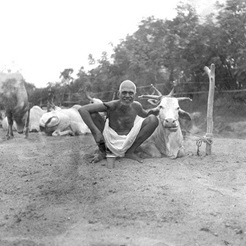
In the state of the false I man is alienated from his own inner being, which reflects itself in his estrangement from other beings, from his fellow-men, from the animals, which inhabit the world he lives in. So man has become divorced from the supreme love, which is his own true nature. The false I or Self, so we have seen, is the true I or Self in a state of self-contraction. What has become contracted, confined is the unbounded pure love streaming forth from the true Self. There may still be love flowing out imparting itself to men and animals alike. This, however, is no longer the deep compassion for a suffering animal, which Ramana experienced. Identified as the false I man will experience a diminished love, a reduced empathy only for the animals of this world. In his alienated state he may, as a matter of fact, not be concerned with the feelings of animals at all. There will, however, be no doubt in his mind that animals do have feelings. He or she will always know that a dog does experience a sensation like physical pain, for example. c) Descartes to prove his theory nailed his wife's dog to a boardDescartes, who has become entrapped in a deeper alienation from his true nature, does not know this. It is a mode of consciousness, in which not only all compassion and caring for the animals of this world has been wiped out. A more deeply estranged Descartes arrived at the metaphysical conclusion that the animal, being a non-thinking thing, cannot experience any sensations at all. To test his theory, he nailed his wife's dog to a board and chopped it open while the poor thing was still alive. (http://knowledgenuts.com/2013/09/29/descartes-dissected-his-wifes-dog-to-prove-a-point/)
His wife did not object to the experiment he conducted. Like attracts like. So were Descartes and his wife birds of a feather that flocked together to engage in a doggish experiment? Or did his wife simply stay away from Descarte's chopping exploration, feeling happy that she was on the safe thinking side. So she had good reason to remain unperturbed by the screaming cries of the non-thinking thing nailed to a board. I know of no literature delving into the relationship of Descartes and his wife with the dog in their midst. So I do not know what to say. Descartes in Meditation III was engaged in metaphysical ratiocinations, which carried him to an ultimate proof for the existence of God. In The God Delusion Richard Dawkins contends that a supernatural creator almost certainly does not exist and that belief in a personal god qualifies as a delusion. Let us see how Dawkins views Descartes' scientific explorations. He writes I find it almost impossible to believe that Ren� Descartes, not known as a monster, carried his philosophical belief that only humans have minds to such a confident extreme that he would blithely spreadeagle a live mammal on a board and dissect it. You'd think that, in spite of his philosophical reasoning, he might have given the animal the benefit of the doubt. But he...believed...that non-human animals have no soul and feel no pain...Pain feels primal, like the ability to see color or hear sounds...Isn't it plausible that a clever species such as our own might need less pain, precisely because we are capable of intelligently working out what is good for us, and what damaging events we should avoid? Isn't it plausible that an unintelligent species might need a massive wallop of pain, to drive home a lesson that we can learn with less powerful inducement? (Richard Dawkins on vivisection) In SciCrazy we read Can you imagine believing that if you torture an animal and it screams and cries that it's just a robotic reaction. Gary Francione wrote in his Introduction to Animal Rights�that Descartes and his followers held public demonstrations in which they inflicted severe pain onto animals (examples: nailing the paws of dogs onto boards, cutting open their chests to reveal the beating hearts, burning, otherwise mutilating) in order to have the opportunity to educate the crowd to not feel sympathy for these organic 'machines' that were only 'functioning properly.' (scicrazy.wordpress.com)
Descartes was an idealist. So he engaged in a reformatory campaign intended to purge the public from the erroneous belief that animals can feel pain. Nailing the paws of dogs onto boards, cutting open their chests, revealing the beating hearts was intended as a colorful demonstration to persuade the public at large that the screaming of the dogs was the sqeaking of a machine in the process of being dismantled. He wanted to openly drive home the point that the mind and the body were different things. So he reiterated that the thing, which was the mind, could feel pain, whereas the thing, which was the body, could not feel pain. So the general public should see that animals could not feel pain, no matter what physical harm was inflicted on them, no matter how uproariously they screamed and cried. This was the undoubted philosophical conclusion, at which Descartes had arrived, after he had engaged in a long sequence of doubts, in which he had questioned everything that could possibly be a concern within philosophy. In his ratiocinations he had been driven by the urge to get rid of all preconceived ideas that might lead him to misguided conclusions, that might bring him to faulty deductions. He wanted to discard all suppositions, all assumptions, leaving only what he could be certain of. The crowning result of his reflections was the thinking thing of a mind, which had feelings, and the non-thinking thing of a body, which had no feelings. d) What Descartes clearly perceives, is distinctly wrongLet us look more closely now first into Descarte's ongoing doubts, then into the discovery of the undoubted thinking thing, which he himself believed to be. A doubting Descartes inquired: How do you know what you see, what you experience is real and not just an illusion born from your imagination? His answer was: You don't truly know. You can't prove anything.

So Descartes asked himself whether there was anything which could not be doubted. He arrived at the conclusion that there was indeed something, which could not be questioned. This was the doubt itself. A doubt is a thought of doubt, he asserted. What I cannot doubt, is the existence of the thought. So the thought is some-thing that exists. A thought has to be thought. So the thought implies thinking. Thus thinking is a process, which exists. The thought is thought by the thinker. It is the thinker, myself in this case, who is engaged in the process of thinking, says Descartes. So it can be firmly asserted that I think. An existing thing can only originate from an existing thing. As thinking exists, I exist as a thinking thing. This takes us to the undoubtable conclusion: I think, therefore I am. Descartes in his line of argument made himself into a thinking thing. He first doubted his own existence. It is a doubt which was resolved in a line of argument, which lead him to the conclusion that he existed as a thinking thing. So he asserted: I think, therefore I am. The conclusion of the I am, at which he arrived, lies inherent in the notion of the I think, on which his ratiocinations are built. Descartes deduces from his argumentation an I which he had projected into his line of argument. This did not occur to the doubting Descartes. So he gloriously turned around in a vicious circle, with the conclusion of an I am, which confirmed the preconceived notion of an I think, on which his meditations were built. To drive home his unassailable conclusion in public presentations he continued to drive nails into the paws of dogs to demonstrate that they were non-feeling, non-thinking things as opposed to the feeling thinking thing, which he himself was. In "I think, therefore I am" we find two phrases, which are linked through an intermediary therefore. The conjunction therefore is not meant as a causal copula. It is to be understood as a temporal tie. What Descartes wants to say is this: As long as I think, I am. Let us say I think: To-morrow my brother will come to see me. He will pay me a visit, because he had promised to do so. Now my brother is a trustworthy fellow who has a habit of keeping the promises he makes. Still there is no absolute guarantee that he will see me to-morrow. He is in a state of good health, but you never know in this world. So he may no longer be alive to-morrow, which holds true for me as well. So I must doubt the statement, which I made. What I cannot doubt - to stick to Descarte's line of argument - is the thought of doubt, in which I am engaged. As I think the thought of doubt, I know that I am. To know that I am, I must think this thought now. When I do not think this thought, I do not know that I am. So I can only know that I am, as long as I think that I am. When I do not engage in this thought, there is no knowledge of my existence. So in order to know that I am I have to repeat endlessly: I am, I am, I am... Let us say someone you meet keeps on repeating: I am, I am, to persuade himself that he exists. So you may wonder what the reason is for this bizarre, severely deranged behavior. In the case of the thinking thing, which Descartes believed to be, we know the reason. It is to be found in the vicious circle of his metaphysical ratiocinations. e) Descartes says: I think, therefore I am. Vedanta says: I am, beyond all thought
What we in our everyday speech call I is an illusion, as I tried to show in this essay. Consciousness/emptiness attempts to make Itself into a You, into an object. The result is the false I. It is a process of identification, in which consciousness/emptiness remains what It is. It is only in a contracted state now. There is no I as an author of this or that action. All these activities keep on flowing from consciousness/emptiness. It all happens. We say: I go to sleep. There is no I, however, putting myself to sleep. In case you doubt this, just try the following experiment. Lie down in your bed at night and say to yourself: To-morrow I want to be in good shape. For this I must go to sleep in a little while. So I want to make sure that in three minutes from now I will be sound asleep. The very effort of going to sleep will prevent you from falling asleep. As long as you deliberately try to fall asleep you will stay awake. So you have a good method now, which will keep you awake. Not I fall asleep, it falls asleep, it drops off, nods off. You say: During the night I was in a dreamless sleep. In the dreamless sleep what we call I was not present. So there was no I who was asleep. It was dreamlessly asleep. You say: Then I started dreaming, to describe the dream you had. There is no I who starts a dream. I am not the author of this dream or that dream. I do not lie in bed at night to decide: I want to dream of this beautiful woman. What was her name? Yes, Mary, that is her name. So I will dream of Mary. You do not say after ten minutes or so: I am tired of dreaming of Mary. So I have decided to dream of Susan now. What you call I, is not the author of these dreams. Not I dream. It dreams. While engaged in a dream I do not say to myself: I have dreamt long enough. So I will wake up now to brush my teeth. Nobody will say this, because not I wake up. It wakes up. So you are awake now, while thoughts come and go. So you say: I think. This, so we have seen is only a manner of speaking. There is no thought coming. There is no present thought or thinking. Think a mile I say, and you have already thought a mile. There is no thought present. So there is no I producing this or that thought. I do not think. It is not even right to say: It thinks. We must say: It has been thought.

In Vedanta there is nobody who goes to sleep, nobody who is asleep, nobody is there to dream, to wake up in the morning. In Vedanta it all happens. To say that it all happens is a thought. A thought has been thought. So it is not even right to say that it all happens. We must say: It all has happened. When I say that I think, I merely abide by a convention of speech. Rightly considered I must say: It has been thought. So Descarte's I think therefore I am turns into: It has thought, therefore it has been. In Vedanta I am not this persona or mask endowed with these qualities of being superior, inferior, attractive, repulsive. As this person(a) I am somebody. When the persona, the mask, has been lifted what remains is nobody. In Vedanta it is not: I am this or that person. In Vedanta it is just: I am. This is the pure being, which is beyond all thought. In the I am "I" has become immersed in "am", in beingness. So the emphasis is on "am". Thus in the Vedanta of Ramana, of Nisargadatta it is I am, as portrayed under photo below. In the metaphysics of Descartes it is: I think therefore I am. As the "I" Descartes is identified with the thinking thing, which he believes to be. So the emphasis is on "I". Thus in Descarte's metaphysics it is: I am.
To summarize: For Descartes it is: I am (a thinking thing). In Vedanta it is: I am (beyond all thought).
In case you have a reading knowledge of German you can go now to my Page www.satsa.de, Texte 6. Ich denke, also bin ich nun?
Let us turn to Richard Dawkins again who stated: I find it almost impossible to believe that Ren� Descartes, not known as a monster, carried his philosophical belief that only humans have minds to such a confident extreme that he would blithely spreadeagle a live mammal on a board and dissect it. (Richard Dawkins on vivisection) When I contemplate on Descarte's I am, on the thinking thing which he believes to be, I find that this I am, if not a monster, is at least grotesquely, monstrously looking. Now you can turn to the Ken Wilber Video, entitled "Descartes: Reviving the West's Greatest Modern Vedantist":
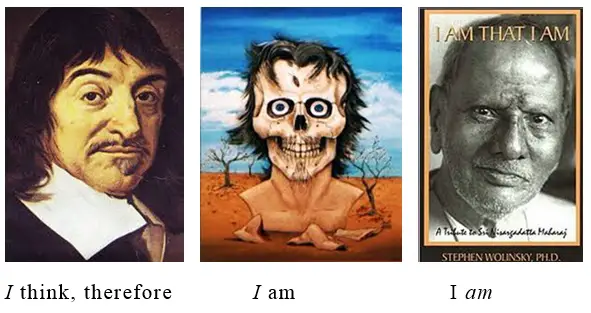 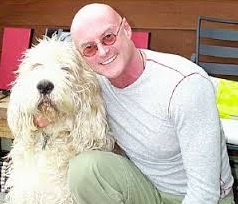
19. Ken Wilber and his poodle: A comforting sightKen, in case you read this, let me state, after the depressing story of Descartes and his wife's dog I am glad to include this photo, which portrays the love you feel for your dog. It is a comforting sight to conclude the article with, because it reminds me of the caring love Ramana felt for his cow Lakshmi. What is the name of the darling poodle? Can you tell me, Ken? I would like to know.
ReferencesAll literature is listed by date of publication at the end for quick reference David Kalupahana, Causality: The Central Philosophy of Buddhism. The University Press of Hawaii, 1975 R. D. Scott, Transcendental Misconceptions, Beta Books, 1978 The Fundamental Wisdom of the Middle Way, Nagarjuna's Mulamadhyamakakarika, Translation and Commentary by Jay L. Garfield, Oxford University Press Nagarjuna's Mulamadhyamakarika, 1995 Ken Wilber, The Spectrum of Consciousness, Theosophical Publishing House, 1999 Suzanne Segal, Collision with the Infinite, A Life Beyond the Personal self, New Age Books, 2009
|